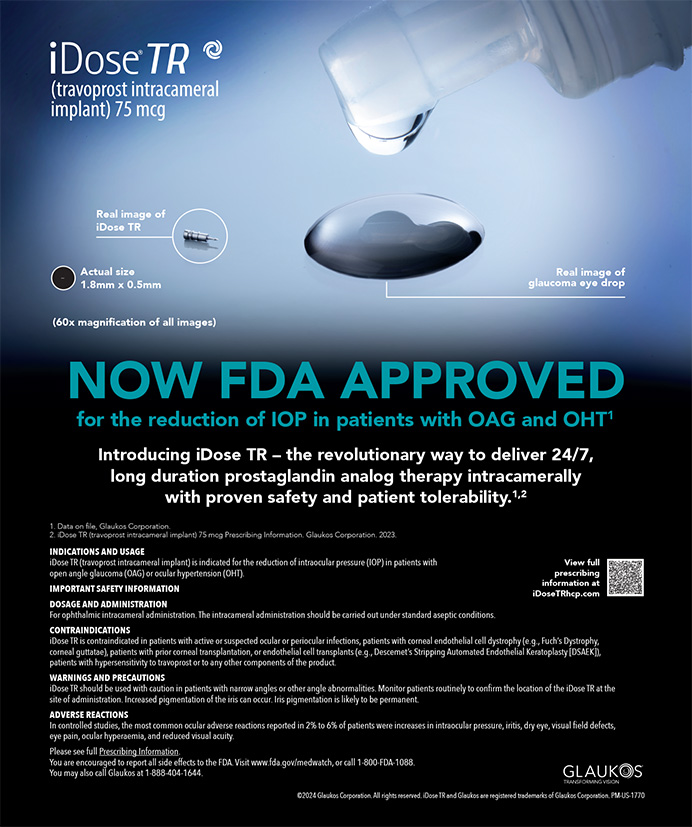With its new Stellaris Vision Enhancement System (FDA approved, commercial launch in US planned for April 2007) (Figure 1), Bausch & Lomb (Rochester, NY) has designed an integrated phaco platform with advanced technology and precise instrumentation that will facilitate surgeons' transition to the newer microincisional phaco techniques. The system's unique fluidics, power modulation, and precise controls are optimized for any of three phaco approaches: standard coaxial; bimanual sleeveless microincisional; and microcoaxial (through a 1.8-mm incision).
ABOUT THE SYSTEM
When I joined the Stellaris development team 3 years ago, our goal was to imagine and build the phaco machine of the future. To that end, we solicited input from 200 ophthalmic surgeons and 40 nurses worldwide. The resultant phaco platform has an array of high-tech capabilities and a modular design that will allow easy upgrading in the future.
The Stellaris also addresses some practical issues that the survey respondents said impeded surgical efficiency with earlier phaco machines. For instance, the system's wireless foot control reduces clutter in the OR and is responsive and precise. A six-crystal titanium handpiece is small, light, and shaped to avoid fatiguing the surgeon's hand. A locking infusion line connector means no surprise disconnection during surgery and thus prevents a loss of infusion and the chamber's collapse.
Surgeons may choose either vacuum- or flow-based fluidics. The totally electric system for vacuum-based fluidics exceeds the performance of Bausch & Lomb's Venturi system and no longer requires external compressed gases. In addition, the Stellaris features improved fluidics sensing and control, which permit the use of vacuum as high as 600 mm Hg. Optional high-vacuum, flow-resistant tubing incorporates a mesh filter to capture lenticular particles larger than 0.3 mm before they can reach the lumen of the evacuation line. The tubing thus maintains the chamber's stability.
The Stellaris features advanced power modulations with hyperpulse settings of up to 250 pulses per second and duty cycles with on times as low as 2 milliseconds. Square-wave and waveform modulation may be used with the pulse or burst mode.
The system's 18-inch, high-resolution screen with advanced graphic and animated displays is intuitive to use and designed to enhance operational efficiency. An optional window on the screen shows real-time video of the surgery and thus eliminates the need for a second monitor for the surgeon's assistant. The Stellaris' internal modularity facilitates upgrades and speeds technical service, and the system has an online capability for diagnostics or preventative maintenance.
THE NEEDLE AND SLEEVE
One year after joining the Stellaris design team, I began a parallel project working on the new needle and sleeve combination that would be optimal for microcoaxial phacoemulsification. My initial experiences with the Stellaris and a prototypic sub–2-mm needle/sleeve combination suggested that the microcoaxial approach might be a simple, easily learned way for surgeons to transition to using smaller incisions. Unlike with bimanual sleeveless microincisional surgery, I could not discern any difference from my standard coaxial cases.
Our aims were as follows. We wanted to eliminate the learning curve for surgeons transitioning to microincisional phacoemulsification. We also wanted to make the microcoaxial method compatible with any surgical technique (eg, chopping, divide and conquer, phaco flip, supracapsular phacoemulsification). In addition, we wanted to make microcoaxial surgery compatible with either high or low flow and high or low vacuum, according to the surgeon's preference. Finally, we sought to eliminate the need for excessively high or pressurized infusion bottles.
Using computer-modeling software, we determined the minimum needle lumen that could maintain excellent followability, vacuum holding force, and aspiration. Then, we reduced the thickness of the needle's wall while preserving the instrument's structural integrity. Next, we modeled the minimum clearance needed between the needle and sleeve to deliver a safe volume of infusion in high-vacuum cases. The sleeve's wall was thinned, and its ports were redesigned to deliver more infusion laterally for improved followability at the needle's tip.
On October 30, 2006, I performed the first eight human phaco procedures with the Stellaris. Half were microcoaxial cases using a needle/sleeve of the computer-optimized design (Figure 2). I performed two of the microcoaxial cases with flow-restrictive tubing and vacuum of 600 mm Hg. I performed the other six cases (four coaxial, two microcoaxial) at 300 mm Hg vacuum. The bottle's height was 125 cm for all eight cases. I performed cortical cleanup through the 1.8-mm incision with a standard 0.3-mm I/A handpiece fit with a microcoaxial sleeve. There was excellent chamber stability using linear vacuum of up to 600 mm Hg. Measurements of all the incisions after I/A revealed no stretching. The new machine and needle performed flawlessly. There were no complications, and all surgical parameters were evaluated as excellent.
CONCLUSION
With the Stellaris, surgeons have the option of choosing microcoaxial phacoemulsification as a simple alternative to bimanual sleeveless surgery. I myself favor the microcoaxial approach to sub–2-mm surgery, because it offers the advantages of a smaller sideport incision (0.5 mm or less), a sleeve-protected needle, and less incisional stress and distortion than bimanual sleeveless surgery.1 These factors are all important to improving the seal of the incision and potentially reducing the risk of postoperative leakage and endophthalmitis.
It is noteworthy that the ASCRS white paper in September 2006 discussed the association between clear corneal incisions and postoperative endophthalmitis. The paper's authors concluded that wound architecture is the most significant potential risk factor.2 Paul Ernest, MD, had earlier demonstrated that square tunnel incisions are more resistant to deformation and leakage than rectangular tunnels.3 Stress placed on the incision during surgery might prevent the tight closure of a clear corneal wound, which could allow contaminants and bacteria to enter the eye. One study by Mikhail Boukhny, MD, showed that a sleeveless phaco needle produces five-and-a-half times more stress on the incision than one with a sleeve.1 In addition, the ASCRS white paper noted that the sideport incision must also be recognized as a possible source of contamination.2 With bimanual sleeveless phacoemulsification, this wound is usually approximately 1.5 mm long and is subject to stress from the infusion chopper.
Microcoaxial phacoemulsification eliminates many of the aforementioned concerns. A 1.8-mm clear corneal incision results in a square tunnel through which it is easy to work. In addition, the infusion sleeve minimizes stress on the incision, thereby improving its seal and eliminating the need for a separate incision for the IOL. Finally, the surgeon may construct the sideport incision as a 0.5-mm square, and it will not be subjected to stress, because choppers or nucleus rotators may be made smaller if they do not need to deliver infusion. Compared with bimanual sleeveless phacoemulsification, I also find that the microcoaxial instruments are easier to maneuver in the eye, and I have greater flexibility in my choice of technique and fluidics.
As more surgeons have an opportunity to evaluate the Stellaris microcoaxial platform, the development of many alternative fluidics settings and power modulations is likely, and they should further improve patients' safety and surgical outcomes.
Terence M. Devine, MD, is Chief of Ophthalmology at The Guthrie Clinic in Sayre, Pennsylvania. He is a consultant to Bausch & Lomb. Dr. Devine may be reached at (570) 882-3223; devine_terence@guthrie.org.


